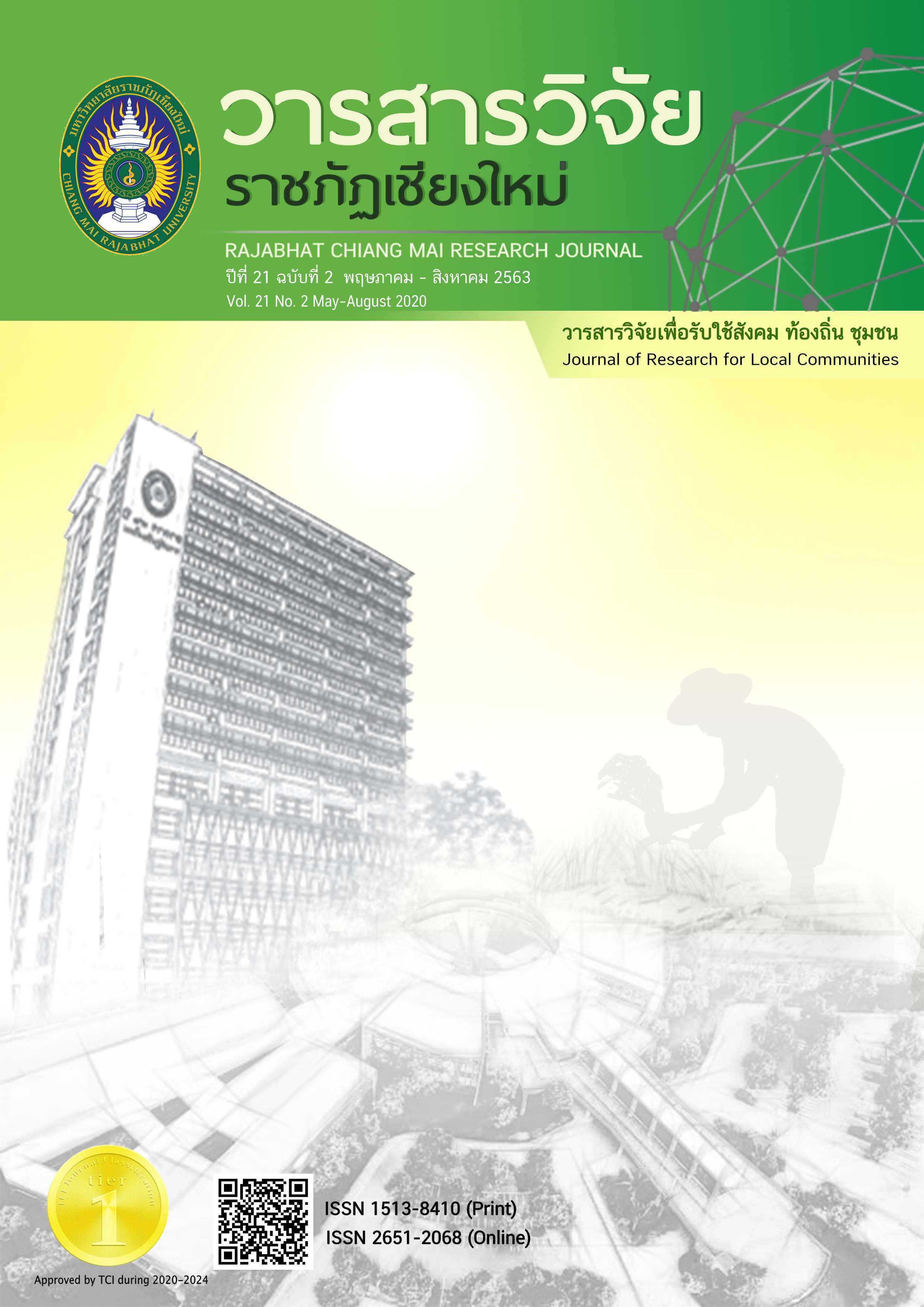การพัฒนาหลักสูตรฝึกอบรมอาจารย์ผู้สอนรายวิชากรีฑาของมหาวิทยาลัยราชภัฎ
DOI:
https://doi.org/10.14456/rcmrj.2020.238357คำสำคัญ:
กรีฑา, อาจารย์ผู้สอน, หลักสูตรฝึกอบรม, มหาวิทยาลัยราชภัฎบทคัดย่อ
การวิจัยครั้งนี้มีวัตถุประสงค์เพื่อพัฒนาหลักสูตรฝึกอบรมอาจารย์ผู้สอนรายวิชากรีฑาของมหาวิทยาลัยราชภัฎ โดยการศึกษาวิจัยแบ่งออกเป็น 3 ขั้นตอน คือ 1) การศึกษาสภาพ ความต้องการ และความจำเป็นในการฝึกอบรมอาจารย์ผู้สอนรายวิชากรีฑาของมหาวิทยาลัยราชภัฏ โดยทำการศึกษากับอาจารย์ประจำสาขาวิชาพลศึกษาที่มีบทบาทเป็นอาจารย์ผู้สอนรายวิชากรีฑา ในมหาวิทยาลัยราชภัฏและทำการศึกษาวิเคราะห์และสังเคราะห์ เอกสารแนวคิด ทฤษฎีเกี่ยวข้อง และการสัมภาษณ์เชิงลึก (Indepth interview) กับผู้เชี่ยวชาญ ด้านการจัดทำหลักสูตรการฝึกอบรมและการสอนรายวิชากรีฑา จำนวน 5 คน 2) การสร้างหลักสูตรฝึกอบรมอาจารย์ผู้สอนรายวิชากรีฑาของมหาวิทยาลัยราชภัฏ ดำเนินการประชุมเชิงปฏิบัติการ (Workshop) โดยอิงผู้เชี่ยวชาญจำนวน 5 คน เพื่อร่างหลักสูตร คู่มือการใช้หลักสูตร และเครื่องมือการประเมินหลักสูตร และ 3) การทดลองและประเมินผลการใช้หลักสูตรฝึกอบรมอาจารย์ผู้สอนรายวิชากรีฑาของมหาวิทยาลัยราชภัฏ ทำการจัดอบรมเพื่อทดลองใช้หลักสูตรฝึกอบรมอาจารย์ผู้สอนรายวิชากรีฑาของมหาวิทยาลัยราชภัฏ กับกลุ่มตัวอย่างที่เป็นอาจารย์ราชภัฎ จำนวน 30 คน โดยทำการเก็บรวบรวมข้อมูลด้วยการเปรียบเทียบผลสัมฤทธิ์ก่อนและหลังฝึกอบรมหลักสูตรฯ ของอาจารย์ผู้สอนกรีฑา และประเมินความพึงพอใจหลักสูตรการฝึกอบรมอาจารย์ผู้สอนรายรายวิชากรีฑาของมหาวิทยาลัยราชภัฏ กับอาจารย์ผู้สอนกรีฑาที่เข้ารับการอบรมฯ
ผลการวิจัยตามละเอียดดังนี้ 1) การศึกษาการสำรวจสภาพ ความต้องการและความจำเป็นในการฝึกอบรมอาจารย์ผู้สอนรายวิชากรีฑาของมหาวิทยาลัยราชภัฏ พบว่า อาจารย์ผู้สอนมีความคิดเห็นเกี่ยวกับสภาพ ความต้องการและความจำเป็นในการฝึกอบรมอาจารย์ผู้สอนรายวิชากรีฑาของมหาวิทยาลัยราชภัฏ ประกอบด้วย ด้านองค์ความรู้ที่จำเป็นต่อการสอนรายวิชากรีฑา ด้านการจัดการเรียนการสอน ด้านบทบาทหน้าที่ในการพัฒนาผู้เรียนรายวิชากรีฑา และด้านนักศึกษา นอกจากนี้ในส่วนของความต้องการในการพัฒนาหลักสูตรฝึกอบรมอาจารย์ผู้สอนรายวิชากรีฑาของมหาวิทยาลัยราชภัฎ พบว่า อาจารย์ผู้สอนส่วนใหญ่ไม่เคยเข้ารับการฝึกอบรมเพื่อเตรียมความพร้อมในการสอนรายวิชากรีฑา ซึ่งทำให้อาจารย์ผู้สอนมีความต้องการเข้ารับการอบรมเพื่อเตรียมความพร้อมในการสอนรายวิชากรีฑา
2) การพัฒนาหลักสูตรฝึกอบรมอาจารย์ผู้สอนรายวิชากรีฑาของมหาวิทยาลัยราชภัฎ พบว่า หลักสูตรฝึกอบรมอาจารย์ผู้สอนรายรายวิชากรีฑาของมหาวิทยาลัยราชภัฎประกอบด้วย 4 หน่วยการเรียนรู้ คือ หน่วยการเรียนรู้ที่ 1 ด้านการจัดทำแผนการเรียนรู้รายวิชากรีฑา มีเนื้อหาการอบรมได้แก่ หลักการและองค์ประกอบและกระบวนการจัดทำแผนการจัดการเรียนการสอนรายวิชากรีฑา การออกแบบแผนการจัดการเรียนการสอนรายวิชากรีฑา และการเขียนแผน หน่วยการเรียนรู้ที่ 2 การจัดการเรียนการสอนรายวิชากรีฑา มีเนื้อหาการอบรม ได้แก่ หลักการจัดการเรียนการสอนภาคทฤษฎีและภาคปฏิบัติรายวิชากรีฑา การจัดเตรียมองค์ประกอบ อุปกรณ์และสื่อ การสอน เทคนิคการจัดการเรียนการสอนภาคทฤษฎีและภาคปฏิบัติรายวิชากรีฑา และการบริหารชั้นเรียน หน่วยการเรียนรู้ที่ 3 การวัดและประเมินผลการเรียนรู้รายวิชากรีฑา มีเนื้อหาการอบรม ได้แก่ หลักการวัดและประเมินผลการเรียนการสอนรายวิชากรีฑา และวิธีการ เครื่องมือที่ใช้ในการวัดและประเมินผล และการประเมินผลการเรียนการสอนรายวิชากรีฑา และหน่วยการเรียนรู้ที่ 4 บทบาทหน้าที่ จรรยาบรรณและคุณลักษณะที่พึงประสงค์ของอาจารย์ผู้สอน มีเนื้อหาการอบรมได้แก่ จรรยาบรรณของอาจารย์ บทบาทหน้าที่ของอาจารย์ผู้สอนกรีฑา และคุณลักษณะที่พึงประสงค์ของอาจารย์ผู้สอนกรีฑา โดยมีระยะเวลาในการฝึกอบรมจำนวน 16 ชั่วโมง จำนวน 2 วัน
3) การประเมินหลักสูตรฝึกอบรมอาจารย์ผู้สอนรายวิชากรีฑาของมหาวิทยาลัยราชภัฎ พบว่า อาจารย์ผู้สอนวิชามีความรู้เพิ่มมากขึ้นภายหลังจากการเข้ารับการอบรมหลักสูตรฝึกอบรมอาจารย์ผู้สอนรายวิชากรีฑาของมหาวิทยาลัยราชภัฎ อย่างมีนัยสำคัญทางสถิติที่ระดับ .01 และเมื่อพิจารณาแต่ละหน่วยการเรียนรู้ พบว่าเป็นไปในทำนองเดียวกัน โดยมีระดับนัยสำคัญในการทดสอบทางสถิติที่ .01 และเมื่อประเมินความพึงพอใจหลักสูตรฝึกอบรมอาจารย์ผู้สอนรายวิชากรีฑาของมหาวิทยาลัยราชภัฎ ภาพรวมมีความพึงพอใจอยู่ในระดับมากที่สุด ซึ่งเมื่อพิจารณาการประเมินเป็นข้อ พบว่า ข้อที่มีความพึงพอใจอยู่ในระดับมากที่สุด 3 อันดับแรก ได้แก่ ผู้เข้ารับการอบรมได้รับความรู้ ความเข้าใจที่ได้รับจากการอบรม จะสามารถนำไปประยุกต์ใช้ในการปฏิบัติงาน ผู้เข้ารับการอบรมได้รับความรู้ ความเข้าใจเพิ่มขึ้น และหลักสูตรการฝึกอบรมมีความสอดคล้องกับวัตถุประสงค์ของหลักสูตรการเรียนการสอน
สรุปผลการศึกษาหลักสูตรฝึกอบรมอาจารย์ผู้สอนรายวิชากรีฑาของมหาวิทยาลัยราชภัฎ สามารถนำไปใช้ในการจัดอบรมได้และมีความสอดคล้องกับวัตถุประสงค์ของหลักสูตรการเรียนการสอน
Downloads
เอกสารอ้างอิง
Dusitkul, C. (2012). The Effects of Physical Education Activity Management by Using Group Dynamic Game on Aggressive Behavior of Elementary School Students. Journal of Education, 7(1), 1057-71.
Jitrodjanarak, R. (2013). 6 Obstacles in Work of Thai Teachers: Teaching Overload and Lacking of Teaching Spirit and ICT Skill. Retrieved from http://www.enn.co.th/5942.
Kanuengpian, A. (2019). Factor Analysis of teacher characteristic in the 21 Factor Analysis of Teacher Characteristic in the 21st Century. Rajabhat Chiang Mai Research Journal, 20(2), 83-94.
Khunaabisit, W. (1991). Physical Education Teaching. Bangkok: Witthayaphat. (In Thai)
Methaphatthara, P. (2006). The Evaluation of Training Teaching Practice in the Workplace. The Journal of Applied Science, 4(1), 28-35. (In Thai)
Nirantranon, W., & Niruntranon, S. (2007). The Trend of Pre – Service Physical Education Teacher in the Period of Fifteen years (2008 – 2022). Udonthani: Institute of Physical Education Udonthani. (In Thai)
Office of the National Economic and Social Development Board (NESDB). (2017). The Twelfth National Economic and Social Development Plan (2017-2021). Bangkok: Porsor Pattana. (In Thai)
Pianchop, W. (1980). Principles and Methods of Teaching Physical Education. Bangkok: Thai Wattana Panich. (In Thai)
Pikrohroek, U. (2013). Education and the Significance of Life. Maha Sarakham: Maha Sarakham Rajabhat University. (In Thai)
Suksai, P. (2018). Physical Education Teacher in the 21st Century. FEU Academic Review, 21(Supplement), 8-21. (In Thai)
Sungthong, P. (2015). Needs in Enhancing Competencies in Internship of Bachelor of Education Program in Physical Education Students. SWU ejournals System, 18(1), 210-222. (In Thai)
Taba, H. (1962). Curriculum Development Theory and Practice. New York: Harcourt, Brace.
ดาวน์โหลด
เผยแพร่แล้ว
รูปแบบการอ้างอิง
ฉบับ
ประเภทบทความ
สัญญาอนุญาต
1. บทความ ข้อมูล เนื้อหา รูปภาพ ฯลฯ ที่ได้รับการตีพิมพ์ใน “Community and Social Development Journal” ถือเป็นลิขสิทธิ์ของ Community and Social Development Journal มหาวิทยาลัยราชภัฏเชียงใหม่ และเพื่อให้เผยแพร่บทความได้อย่างเหมาะสมผ่านสื่อสิ่งพิมพ์และอิเล็กทรอนิกส์ ผู้เขียนยังคงถือครองลิขสิทธิ์บทความที่ตีพิมพ์ภายใต้ใบอนุญาต Creative Commons Attribution (CC BY) ซึ่งอนุญาตให้เผยแพร่บทความซ้ำในแหล่งอื่นได้ โดยอ้างอิงต้องอ้งอิงบทความในวารสาร ผู้เขียนต้องรับผิดชอบในการขออนุญาตผลิตซ้ำเนื้อหาที่มีลิขสิทธิ์จากแหล่งอื่น
2. เนื้อหาบทความที่ปรากฏในวารสารเป็นความรับผิดชอบของผู้เขียนบทความโดยตรง ซึ่งกองบรรณาธิการวารสารไม่จำเป็นต้องเห็นด้วยหรือร่วมรับผิดชอบใดๆ














